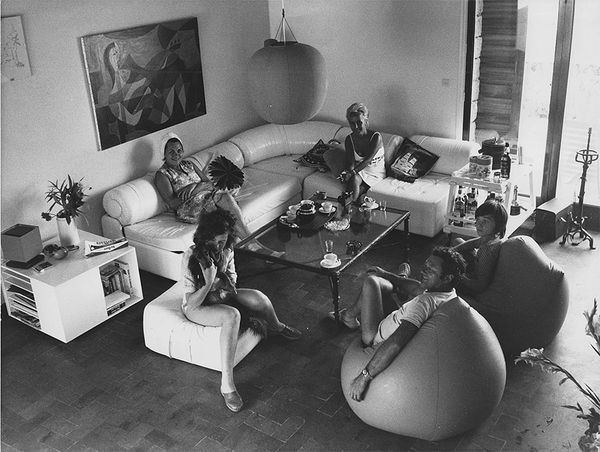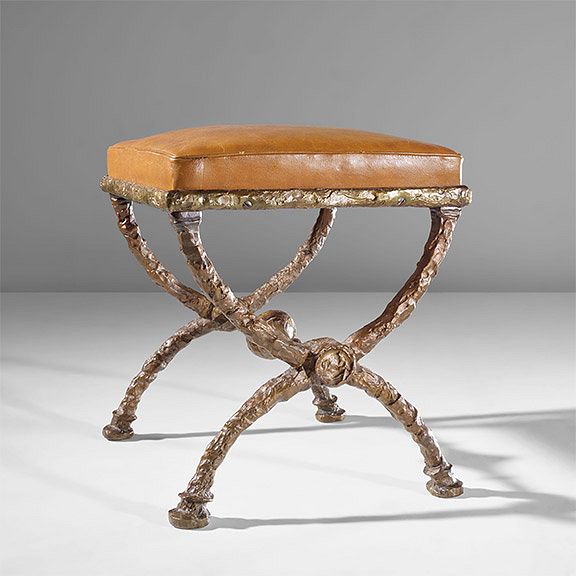The present 'Grecque' low table in the summer house of the original owner, circa 1971. Photo: Private family archive.
At the heart of Diego Giacometti’s familiar style lies an admiration for Antiquity, an interest the artist carried with him for his entire life which initially stemmed from a trip to Egypt in his youth. The influences of ancient Greek and Roman eras lent themselves into proportional ideals present in his furniture designs, which he masterfully executed in bronze.
The present ‘Grecque’ low table and ‘X’ form stool serve as highly desirable and authoritative examples from the most mature period of Giacometti’s artistic career. At this time, he had achieved notoriety for his recognizable, iconic style and conveyance of inimitable sincerity in his precise craftsmanship. From the early 1960s through the remainder of his life, the works to come out of Diego’s atelier embodied a fresh refinement of artistic vision. By meticulously molding his plaster casts, each work possesses individualistic authenticity in its finished state, complemented by the rich patination he supervised himself to bring uniqueness to the distinctly sculpted quality of each piece.
This dedicated approach to detail in his craft attracted the attention of an elite clientele during this period of his career, resulting in a wide range of diverse and important commissions. His ability to play to his clients’ personal tastes led to delightfully intentional nuance within his works, demonstrative of both keen observational skills and thoughtful concern for all aspects of the pieces he produced, while confidently maintaining his own identity for an overall aesthetic that is quintessentially ‘Diego Giacometti.’ The breakthrough to such self-assuredness in his practice from this decade onward commanded increased demand for his artistry which is still beloved today.
Giacometti’s works present themselves as sophisticated pieces that fit perfectly into social, domestic settings. The accompanying image from the early 1970s shows the ‘Grecque’ low table enjoyed in situ within the original owner’s summer house living room, just a few years after it was purchased from Diego. This style materialized through Giacometti’s skillfully developed abstraction of textural details and cast motifs echoing ancient Etruscan artisanship, resulting in works that honor the aforementioned appreciation of Antiquity while showcasing his expressive range of varied patinas. These pieces echo the austerity of classic ideals while simultaneously meeting the viewer with a convivial sense for modern living. This balance is further complemented by the tension between the hardness of the cast bronze and the softness of the warm patination for finished works which are both strong and inviting.
Diego Giacometti, ‘Grecque’ low table, designed circa 1965, produced 1968. Design London.
Far from foldable — as were the curule chairs that inspired this form within Giacometti’s oeuvre, which were designed to be easily moved and transported during Ancient Roman times — the present ‘X’ form stool gained its foundations within the artist’s range when Aimé Maeght returned from a flea market with a Spanish wrought iron chair in a similar style. The design’s traditional form amused Giacometti and inspired him to create the present design as an elegant and reimagined homage to stylistic notions of the distant past.
Diego Giacometti, 'X' form stool, troisième version, designed circa 1960, produced 1967. Design London.
These two pieces come to Phillips bearing a pristine provenance, having been acquired directly from the artist at the time of production and having since remained in the same family. They are excellent demonstrations of Diego Giacometti’s expert abilities to blend the disciplines of sculpture and the decorative arts for timeless masterpieces of modern design.
Discover More from Design London >
Recommended Reading
The Emergence of the Master: Ettore Sotsass >
Beauty Suspended in Time: Shiro Kuramata >
A Masterpiece of Brazilian Modern Design >
Elevation of the Human Spirit through Postmodern Design: Alessandro Mendini >


